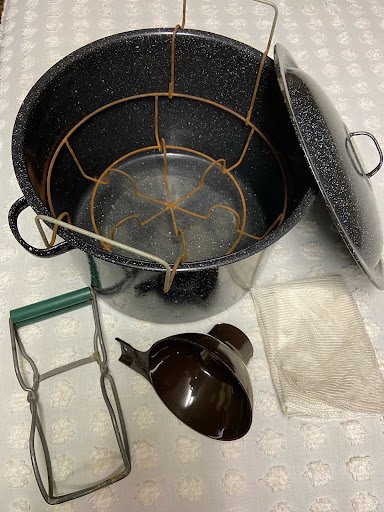Jamming with Grandma - 10 Questions
I interviewed my grandma (a hairstylist, farmer, and avid jammer who lives in Wichita, Kansas) about the jamming process. This is a process she's partaken in for the majority of her life, just like her parents before her, and her parents’ parents, and so on. Below is an abridged transcript of my interview with her and some beginning steps you can take to make delicious and delectable homemade jam.
Q1) Grandma, why do you jam?
“I like it! I like to eat it! I particularly love peach jam, and Alice, my neighbor, also makes the best peach jelly. But honestly, we eat more cherry jelly than anything. If we get tired of the fresh fruit, then we’ll jam it or jelly it to use it up and preserve it before it spoils. We can store it on our shelves for months/years. If it was just regular fruit, like the stuff you’d buy from going to the store, it would spoil and we’d have to throw it away. It’s basically a way to store your product and use it at a later time.”
Q2) How long have you been jamming?
“I used to do it with my mom when I was little, but when I started working I didn’t really have time. But ever since I’ve retired, I’ve been making jelly and canning a lot. My grandparents all did it too, that was how they survived. Refrigeration is a much more modern invention, so it was a way to preserve your food without having to store it in a cooler. After a harvest, you’d have a large quantity of something, and this was a way to eat it at a later date, especially during winter.”
Q3) So what exactly is the difference between the steps of making a jam and making a jelly?
Jam = You use the whole fruit.
Jelly = Just the juice.
Q4) What are your favorite things to jam?
“My favorite thing to jam is peaches or grapes. I also really like the peach jelly with jalapeno peppers in it we make. But you can jam a ton of different things: cherries, blueberries, blackberries, peaches, apples (apple butter)... the list goes on. If there is leftover juices (making other jellies and have more than the quantity needed) I’ll make mixed berry jelly. The best fruits for jellies (different from jam) are cherries and grapes.”
Q5) Now the big question, what are the steps to making the perfect jam?
Here is the chart she uses for proportions of ingredients.
Make sure you have all your ingredients ready:
Fruit (amount specified in image below)
Lemon juice
1 package of pectin crystal
Granulated sugar
Gather all the utensils required as well (and make sure they are clean).
Large pot
Potato masher (or pastry cutter)
Heat resistant spatula/spoon (to stir)
Mason jars with lids
Canning/cooling rack (to put in pot)
Jar lifter (if you have one)
Clean all the fruit you are going to use.
Combine all the ingredients (except sugar) in a pot and use a masher (or pastry cutter) to mash the fruit down into a mush-like consistency.
Put the pot with the fruit mash on the stove, turn the heat onto medium, and stir (constantly) the mixture until it reaches a boil.
Add the sugar and stir for 1 minute.
Then, remove from the heat and pour into sterilized jars (leaving a little bit of room at the top).
Seal and then store, put in the fridge to enjoy later, or eat it right there on the spot!
Q6) So, how do you seal the jar?
Equipment needed for jamming.
Sterilize your mason jars by placing them in hot water on the stove, not quite boiling.
Once the jam/jelly is prepared, carefully take the sterilized jar out of the water and towel dry.
Fill the mason jar with the jam/jelly mixture you just made, leaving a little room at the top for air and screw the lid on loosely.
Fill a big pan with water and bring to a boil.
Set the jars on a canning rack in the boiling water (making sure they’re on the rack and not touching the bottom of the pot - or else they will crack) for 10-15 minutes (or you can use a pressure canner if you have one).
Then remove each with the jar lifter from the bowling water and voilà, sealed jam.
Q7) What if people don’t have mason jars that seal, what can they do?
“If you have a jar that doesn’t seal, you can just put it in your fridge, but make sure to use it pretty soon. The fridge will slow the spoiling process. Sometimes they’ll last at least 6 months - up to a year after being opened in the fridge. Sealing the jar helps ensure the jam stays fresh longer - for years even.”
Q8) How long does the jamming process take?
“It usually takes 4-5 hours once everything is clean and done. It’s a long process and requires patience. It is usually a whole afternoon. This is for 6-8 cans though, a bigger pot might take longer and you’d have to repeat the process. Thankfully we don’t have to wash the fruit super tirelessly since most of what we use is homegrown.”
Q9) What are your favorite family-fun memories of jamming?
“It was and still is a lot of fun to make jam with people, much more fun than doing it by yourself. It’s always an adventure going down to the Mennonite/Amish cart for fruit, as trucks come through with huge boxes full of fruit - you have to scramble and get your pick before others. We often get so much we split it with our neighbors. Honestly, we eat a lot of the fruit fresh, then freeze some, and jam the rest. My favorite is the peaches from Colorado, specifically Palisade, but the ones from Georgia and South Dakota aren’t far behind, they all have a super different taste.”
Q10) And finally, what do you use your jam on?
“We usually eat ours on toast, waffles, pancakes, but if you have a bagel you totally could use it on that. We even put some of the peach-jalapeno jam I mentioned before on our pork burgers/hamburgers, hotdogs, brats, and even pork roast. Speaking of more savory meals, sometimes we make hot pepper jelly, which is just peppers instead of fruit mixed with sugar, it’s super versatile and tasty.”


